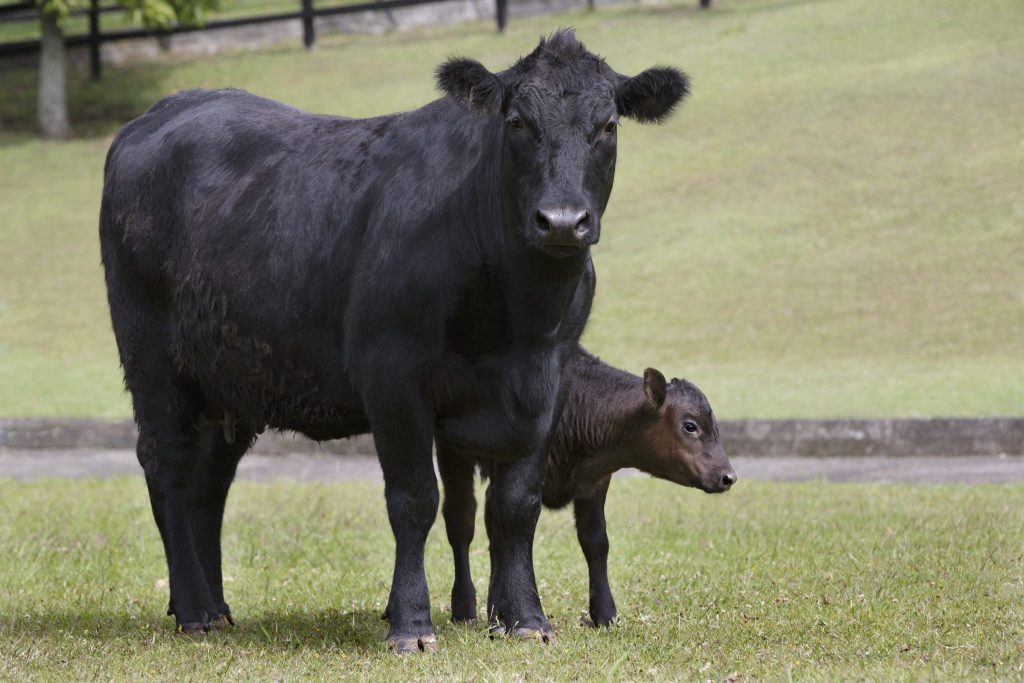
Mark Johnson, Oklahoma State University Extension Beef Cattle Breeding Specialist, offers herd health advice as part of the weekly series known as the “Cow Calf Corner” published electronically by Dr. Peel, Mark Johnson, and Paul Beck. Today, Johnson is talking about what needs to happen promptly after a baby calf is born.
What should happen at the beginning of life for a baby calf to get off to a good start? This week we review the sequence of several steps that need to happen. Some of these we never witness and take for granted when we find a new-born up and nursing. But along the way, if we are watching it take place, this is what we should see:
- The calf begins to breathe. This one is obviously critical. Typically as a calf comes out of the birth canal and the umbilical cord is severed, their first reaction is to inhale. Sometimes, a difficult birth, less calf vigor, amniotic fluid in the nostrils or throat, or part of the amniotic sac covering the nose prevents it from happening. If you are observing the process after delivery, you need to help a calf that is not breathing immediately. First, clear the airway. Use your fingers (or small tube with a bulb on the end) to remove fluids from the back of the mouth and remove anything covering the nostrils. Then, insert a piece of straw into the nostril as a probe to try to stimulate a sneeze reflex. This reflex will cause the calf to blow out fluids from the airway and inhale. It should only take a few seconds. Avoid hanging calves over a fence rail or picking up calves by their rear legs. This is a common mistake. The maneuver only makes it more difficult for the calf to breath by putting the weight of internal organs against the diaphragm and lungs which need to move to bring air in.
- Cleaning and Drying the calf. This is the beginning of the maternal bond during which the cow will lick the calf dry and use her muzzle to stimulate the calf to stand up. Calving this time of year, when calves are leaving the cozy environment of the mothers womb at a temperature of 101-102 degrees F and hitting the grounds at temperatures 60 – 100 degrees colder, make this very important to the calf’s survival. An attentive cow may save her calf’s life simply by cleaning it immediately after birth. The cleaning action accomplishes two things: it removes the fluid soaking the calf and stimulates muscle contractions and circulation in the calf. Both prevent excess loss of body heat from the calf which can be conserved to help it stand and begin the process of finding a teat to nurse. Manually drying and warming may be necessary for a weak new-born or in extremely cold winter weather.
- Nursing. Standing and nursing are extremely critical so that a calf ingests an adequate amount of colostrum in the first few hours of life to acquire passive immunity as well as energy and other nutrients to maintain body heat. In order to have the best chance of survival, a calf needs adequate colostrum within two hours of being born. A calf begins to lose its ability to absorb antibodies from colostrum within six hours following birth and nearly all by 24 hours after birth. Any time you assist the birth of a calf, you should consider giving colostrum with an esophageal tube feeder to the calf before leaving the new pair on their own. First calf heifers with less experience than cows may require a higher level of management and assistance in order to allow steps 2 and 3 to take place. A squeeze chute or head catch will be handy if you find yourself in the situation of assisting with the nursing process.
- The Maternal Bond. After steps 2 and 3 are complete the majority of the bonding process is established, but will continue to strengthen over the next several days. During the first few hours post-calving the cow or heifer identifies her own calf and the calf learns who its mother is. If all is proceeding normally a little privacy is best. Too much interference by humans or other animals can be a distraction and delay the process.
Remember the nutritional requirements of the cow or heifer will increase dramatically once she begins lactation. The general rule of thumb is at least 25% more. The dry cow in the last trimester of pregnancy meeting her nutritional requirements on 24 pounds of forage dry matter per day will need 30 – 31 pounds of the same forage dry matter per day post calving. This is even more critical if you are calving out cows and heifers that are thinner than a body condition score five. Cows in a body conditional of 5 – 6 are better prepared to produce adequate quantity and quality of milk and colostrum needed to get a calf off to a good start.















